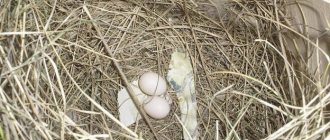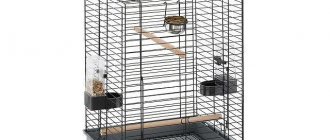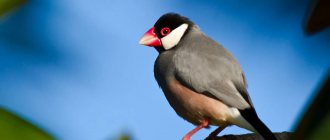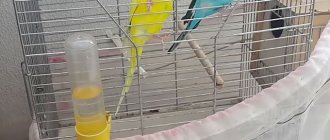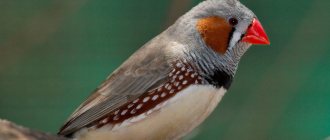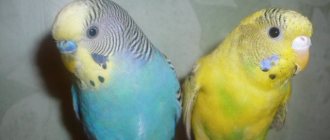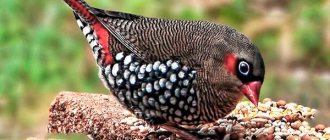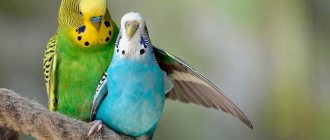Necessary conditions for breeding finches
In order for birds to have healthy, viable offspring, it is necessary to take care of many things in preparation for nesting. If the chicks are planned to appear in the spring-summer, a month before this they begin to do the following:
- Select a pair suitable for age. It’s good if the individuals get along with each other and don’t fight. Breeding birds depends on their mutual sympathy.
- A couple of open and closed nesting places are placed in the cage - the newlyweds themselves will choose a home that is convenient for them.
- Choose a varied, nutritious diet. For the entire period, how many days the birds will have to feed their offspring, they will need strength.
- The room should be warm and light. The duration of daylight hours increases to 14 hours a day. Choose a spacious cage.
- They stock up on a large amount of nesting material (twigs, tree shoots, moss, hay). It will come in handy more than once: birds hatch their eggs on it.
On a note. Threads, cotton wool, and rags should not be used as nesting building materials. The bird will get its claws tangled in them and damage its paws.
It is necessary to take into account all these factors for breeding finches in captivity at home.
How to choose a bird
It is advisable to purchase zebra finch not from pet stores, but from trusted breeders. It is better to purchase a finch in the fall, so that it has time to get stronger and adapt over the winter.
Preference should be given to moderately well-fed, active individuals with clean, non-sticky feathers around the cloaca, pinkish skin, even breathing, shiny eyes and springy energetic movements.
On a note. Emaciated, lethargic finches with a protruding breastbone, ruffled feathers, or bald patches may be diseased. It is better to refuse to buy them.
Zebra finches are active and cheerful birds. They do not require complex care, get along well with people and will be excellent pets for those who do not like silence and are willing to put up with constant background noise.
Nests for future offspring
Installing a nesting box in an aviary is a signal for birds about the beginning of the mating season. For one couple, 2 nests are allocated - they must choose the one that suits them. This is important for finches and their breeding at home.
You can install a regular basket made of wicker or hemp rope. They also use a simple plywood box without a front wall. The lid should be removable, and a small recess should be cut out in the thick bottom, where the masonry will subsequently be placed.
Closed baskets in the shape of a ball are also suitable for nesting and breeding of domestic finches. They are woven from willow branches. You can make a nest from a log by cutting a hole in it for the future family. Twigs, hay, and coconut fiber are also placed there. The couple will use these materials to build a nest for the babies.
Feeding birds during the mating season
The food for finches at home is practically no different from the diet of other parrots - it is a grain mixture of 6-8 components. But commercial food for wavy birds is not suitable for these pets; they choose food specifically for exotic birds.
Soft nutritious foods are added to the grain mixture: boiled eggs, rice porridge, cottage cheese. It is good to germinate wheat grains and feed them to birds during the breeding season. Among vegetables, you can offer cucumber, but greens are prohibited: dill, onion.
It is good to offer the birds to eat sunflower seeds from time to time. During the breeding season, mineral nutrition is important for the female: shell rock, egg shells, sand, small pebbles, chalk. This way she will lay eggs with strong shells.
Preparing a couple for reproduction
2 weeks before the finches mate at home, the male is forced to move a lot. He is released from the cage into the room for a long time and allowed to fly to his heart's content. He will sit on the eggs together with the female. During this period, a mineral supplement is also needed in his diet.
In the female finch, preparation for reproduction lasts longer - 3 weeks. In the first week, she cleanses her body with sulfur-containing supplements. Next week, complex vitamin supplements will be included in her diet. In the third week, increase calcium intake. Calcium gluconate is added to the drink, and crushed eggshells are added to the food.
The preparatory process and laying of eggs should occur after molting or long before it begins. During this period, birds experience great stress on their immune system. Nesting that coincides with the molt will take away their last strength. Sulfur-containing additives for molting birds are given little by little during the mating season.
Description, appearance
Zebra finches (lat. Taeniopygia guttata) are miniature birds from the family of finch weavers, belonging to the order Passeriformes. Their body length does not exceed 13-15 cm, and their weight is 50 g.
They have an expressive, thick and curved bright beak (red in males, pale orange in females and dark gray or black in chicks), which appears translucent from the outside. Small thin legs are colored bright orange.
The plumage of zebra finches is dense and motley. In males, a characteristic feature in color is a series of light and black stripes on the chest and tail, thanks to which the birds received the name “zebra”. Primary plumage colors: gray, orange, black and white.
- Gray top: head, wings, back.
- White belly.
- Orange cheeks and areas under the wings.
- Black stripes near the beak, under the eyes.
- Zebra stripes on the neck.
Laying eggs
After all the preparations are completed, the owner, in anticipation, wonders how soon the finches will begin to lay their first eggs. If the owner’s efforts are appreciated and the birds are provided with a nesting house, then a week after mating, the finches begin to lay eggs. There will be from 4 to 7 pieces in total. A young female has no more than 3 of them. She lays one egg per day. As soon as the finches have laid 2 eggs, they begin to hatch them.
During this period, it is necessary to maintain silence and not disturb the birds. It is better to leave them alone in the room and not approach the masonry. It is important to protect pets from drafts. It is good to find out how many days or days the finch incubates the eggs, so as not to miss the hatching. If the female is not ready to feed the offspring, she will need help.
Content
It is very important to choose a cage that is not too tight. The health and well-being of the bird largely depends on this.
The dimensions of the house should be:
- in length - from 60 to 80 cm;
- width – from 40 to 50 cm;
- in height - from 50 to 70 cm.
This cage can accommodate from four to eight birds.
The cage must contain:
- automatic drinker;
- feeder;
- plastic house or box;
- toys - twigs, pieces of rope, etc.;
- special fixed sticks (otherwise known as perches) so that birds can sit on them.
Comfortable housing is very important for birds
. Note. If it is not possible to buy an automatic drinking bowl, you can buy an ordinary bowl, but not made of iron, since the water in such a bowl quickly oxidizes. This can seriously damage the finch's immunity.
The cage should be installed only in dry places where there are no drafts and the sun does not bake. You can put it in a brighter place during the day, and put it away in dark, but not cold places at night.
Incubation
After the appearance of a nest and clutches in it, it is interesting to find out how many finches hatch offspring. This period will last about 17 days. But this figure is approximate. You can subtract or add 1-2 days: the female does not lay the clutch immediately, but as soon as she collects 2-3 eggs. It is interesting to watch how finches hatch their offspring. They do it together - father and mother. While the female is sitting, he flies off to eat and drink. Then the birds change. If the female does not get up from the clutch, the male feeds her, bringing grains in his beak.
The owner should not worry at all if the finch laid an egg, and he does not know what to do in this case. Nature itself will tell the birds what to do.
If birds are hatching eggs, it is important that the room temperature is 20 °C. Its decrease threatens that in the absence of parents the masonry will cool down. Humidity should also be increased to 60%. This will prevent the eggshells from drying out and the chicks will hatch easily. The conditions for finches during the process of hatching eggs are the same as for other domestic parrots.
It is very interesting and educational to watch finches when they start nesting, but it is not always possible to get offspring. In order for finches to breed successfully, it is necessary to select the right pairs, study the biology of the species, which will tell you how to create the necessary conditions for finches to build a nest, lay eggs and feed chicks. For this purpose, here we will give some tips and recommendations that will allow you to successfully obtain offspring from finches and raise them without much loss.
Conditions for successful breeding of finches
Domesticated species of finches can begin to reproduce at any time of the year, but the best time for this is from March to July inclusive. An earlier start of breeding is undesirable, since long nights continue, there is little light and warmth, the feed contains insufficient vitamins, as a result of which the females do not sit well on eggs, feed the chicks, vitamin deficiencies and other non-contagious diseases appear in the young; later than August, the birds molt in order to begin hatching and feeding the chicks in full force by the spring of next year.
Molting and reproduction of finches.
Caught in molting while incubating or feeding chicks, parents feed the chicks poorly or completely abandon them or lay unfertilized eggs. Unfortunately, some fanciers do not pay attention to these tips and “spoil” their birds, and among the young, weak, frail and inferior chicks appear, which are practically unsuitable as breeders the next year.
Conditions for successful reproduction of finches.
With the onset of the nesting season, a set of external stimuli should be created that promote successful reproduction: length of daylight hours (at least 14 hours), the presence of a suitable partner and normal relationships between them, conditions for the expression of sexual desire (presence of a nesting device), sufficient cage sizes, material for nests, the availability of the necessary food for feeding the chicks.
The absence of any of these stimuli can lead to blocking of the reproduction process by the neuroendocrine system. A change in the set of video-specific stimuli, constant stress, poor nutrition and care can slow down or make it impossible for finches to reproduce normally.
Preparing for breeding finches
It is best to keep finches, especially during the nesting season, in pairs in a separate cage. If there are several pairs in a large cage, then the birds mate more easily, but the end results are worse. Failures are more often explained by mutual interference, as finches interfere with each other, climb into other people's nests, take away nesting material, quarrel, etc.
Before the start of the nesting season, the cage (aviary) is disinfected, after transplanting the finch into a temporary room. After disinfecting and drying the cage, bedding is poured onto the tray, clean water is poured into the drinking bowl, food is placed in the feeder, and a nesting device is hung from the upper holes of the cage. Moreover, it is better to hang the nesting device from the outside of the cage, since in this position it will not hinder the flight of birds. It is advisable to have two nesting devices in each cage for one female. If the cage contains several pairs together, then the number of nesting boxes should be hung based on the nest for each pair plus one extra. With such a ratio of the number of nesting sites and breeding females, quarrels between them over the nest will not arise.
Formation of pairs of zebra and Japanese finches. How to make a pair of finches correctly.
In captivity, birds often form homosexual pairs, which, when selecting pairs from Japanese finches, sometimes makes this process very difficult, and mistakes often occur. Therefore, before placing birds, it is necessary to determine their exact gender based on their behavior. Males behave more energetically than females, and although the song of Japanese finches is barely audible, with prolonged observation it is still possible to accurately determine the male. In zebra finches, except for the white variety, it is very easy to distinguish between male and female. Males sing well and beautifully, but females do not, and besides, they make sounds similar to the sounds of a child’s pipe. In zebra finches of the white and light varieties, males are determined only by song, since the weaker color of the beak, which is characteristic of females, can lead to a mistake if the male is still young or inferior.
It is easiest to select pairs when finches are kept in a small flock. After getting used to it, the birds can be placed in pairs in cages, but at first you should constantly watch them, since the result of incompatibility may be the death of one of them after a quarrel. If a male or female behaves aggressively, they should be seated and a different partner should be selected for each. I have never observed quarrels among Japanese finches; these birds are very peaceful, and sometimes they even all spend the night in the same nest.
Breeding work when creating a pair of finches.
When selecting pairs, breeding work should be carried out, which means that the male and female must belong to the same species. It is desirable that their parents also be of the same variety, thus creating a pure breed of zebra finch with characteristic features for this variety.
The main role in the appearance of good qualities in the offspring is played by the female, who passes on to the offspring not only the qualities of a good hen, but also songbirds.
Therefore, females with such qualities must be valued, since they produce good offspring with the necessary characteristic features of this variety. The opinion that a female, in addition to good maternal qualities, is of secondary importance in the transmission of hereditary qualities is incorrect. From the above it follows that it is impossible to mate a male of one species with a female of another. Also, you should not mate a female or male of good quality with a female or male of dubious origin.
Inbreeding. Rules for inbreeding when breeding finches.
Mating of finches that are closely related is strictly unacceptable. As an exception, in the absence of other possibilities, mating of males with their daughters or females with young males descended from them is allowed.
Closely related mating (inbreeding) usually results in extremely frail, poorly developing offspring, and this requires serious culling of the young. Inbreeding is used very rarely, for example, during selection and breeding work, when a new variety of finch is bred. Therefore, it is better to purchase finches from different hobbyists, then inbreeding can be avoided.
Incubation of eggs by a pair of finches
If the pair is chosen successfully, then at the sight of the nesting device the male begins mating games and tries in every possible way to get the female to pay attention to him. Having ruffled the feathers on the back of his head, the male zebra finch flies up to the female, sings and slowly, as if with caution, jumps closer and closer to his chosen one. With each jump, he twitches his tail, and if she is located towards him, then she expresses greetings to him in a silent squat: she ruffles the plumage on her head, cheeks and abdomen, and moves her tail. After the finches sit side by side, fingering the feathers on each other’s heads, we can assume that their union has taken place, and after a short period of time they begin to mate and build a nest in the house. Amadina nests are made from dry grass, which must be placed in the cage and some in the nesting box to attract birds.
Causes of death of chicks and embryos in finches.
After building the nest, the female lays 4–5 eggs and begins to incubate them. This lasts about 12 days. Sometimes it happens that from fertilized eggs not a single chick is hatched or only a part is hatched, the rest die in the embryonic stage. This can occur from contamination of the egg shell, the presence of parasites (fleas, ticks) in the nest and other reasons.
The role of the male and female in finches in the process of incubation of the clutch.
In finches, the male and female incubate alternately, but more often the female spends more energy on this procedure. At first, she often leaves the nest, but then sits down and comes out only to eat and drink water. If the male replaces the female normally, then the process of incubating the eggs goes smoothly and the female does not become exhausted. But sometimes there are males who perform marital duties poorly. In these cases, you should add more food of animal origin so that the female is well-fed.
Feeding finch chicks
A few hours after hatching, the chicks are already able to accept food from their parents. At first only the female feeds them, after a week the male also joins in feeding: before that he fed only the female. When feeding chicks with finches, special attention should be paid to balancing the diet with the necessary feed.
Even with an abundance of plant foods in the diet, finches especially need a balanced diet during the period of feeding chicks, containing, in addition to grain food, food of protein origin. The so-called mash for finches is being prepared. The easiest insects to find are bloodworms and mealworms, which you can buy at a pet store or get yourself. Bloodworms are widely used to feed aquarium fish, and mealworms are used to feed insectivorous songbirds. However, adult finches should be accustomed to the mentioned food before they mate. For this purpose, bloodworms, mealworms, boiled egg yolk or egg powder are mixed with soft food to which adult birds are already accustomed. To avoid poisoning, live food should be given with caution, thoroughly washing each individual. Industrial egg mixtures for chicks are also widely used.
Zebra and Japanese Finches chicks fledge - feeding changes
When the chicks begin to fledge, it is advisable to give them seeds of weeds and meadow grasses. Probably, ripening seeds at the stage of milky ripeness are not only rich in vitamins and minerals, but also very tasty, since adult finches eat them first and feed them to the chicks shortly before they fly out of the nest. Sprouted grains are introduced into the diet. It is rich in amino acids. How to prepare sprouts, see the link https://amadinagoulda.ru/index/proroshhennoe_zerno_v_racione_amadin_gulda_gotovim_prorost/0-290 In a park, garden, field or forest, you can always find ripening grass seeds and prepare them in sufficient quantities. A bouquet of grass with unripe seeds is hung from the cage bars not far from the perch, so that it is convenient for the birds to peck at the delicacy. If the parents feed the chicks well, then, well-fed, they are calm and make a sound only when a male or female appears near the nest. The chicks lie huddled together, their crops are filled with food, and their skin is smooth, without folds or wrinkles. If the chicks' crops are poorly filled with food, then it means that the parents, especially the female, are not feeding them well.
The second important condition for successful feeding of zebra finches chicks is the quality of the food.
It should always be fresh and “attractive”. Finches do not eat stale food actively enough, and they develop diseases of the gastrointestinal tract. Even with the abundance and variety of surrogate food, but of poor quality, the chicks grow slowly and develop poorly. Chicks of finches encourage their parents to feed not only by squeaking, but also with a wide open beak and various movements of the head, neck, and body. The monotonous squeak of the chicks in the nest should be considered as an acoustic signal that establishes a connection between the parents and the brood. Amadine chicks have peculiar formations in the corners of their mouths that focus and reflect light towards their parents; they also have well-developed tactile properties of the oral cavity, since the success of feeding in the semi-darkness of the nest largely depends on the direct contact of the chicks with their parents.
Zebra and Japanese finches chicks leaving the nest.
After the chicks fly out of the nest, the male does not leave them for about two more weeks, feeding them until they learn to feed on their own. At this time, the female begins to hatch the chicks again. To do this, shortly before the chicks fly out of the nest of the first brood, a second nesting device is installed on the other side of the cage, in which the finches build a new nest and the female lays a second egg. If this is not done, she will lay eggs in the old nest and will disturb the chicks, who will therefore leave it prematurely or crush the eggs during the night. In finches, the nest should not be cleaned while feeding the chicks, and after the young have fledged, the nest is cleaned of old material, disinfected with boiling water and put in place for laying eggs and feeding the chicks of the next brood.
Raising young finches
Finally, the chicks flew out of the nest and became completely independent. They sit confidently on the perch, their bodies are well-fed, but this does not mean that all the dangers are over. The flight of chicks is no less important for the hobbyist than the keeping and mating of adult finches, their incubation of eggs or the feeding of offspring by birds. At this time, you should pay attention to their behavior, strictly monitor the availability and variety of food, and maintain a normal temperature. The chick may choke in water when it wants to quench its thirst, or in a bathtub. Therefore, in these vessels, before the chicks fly out of the nest, the depth of water should not exceed 1.5 cm, but it is better to use pneumatic drinkers for water and temporarily abandon bathing, which will avoid accidents. The chicks may also die if, after leaving the nest, the birds refuse to fulfill their parental responsibilities. For such cases, you need to have foster parents, the best of which are Japanese finches, which hatch and feed the chicks well.
Foster parents Japanese finches
A variety of finches are used as foster parents, which hatch and feed the chicks well. However, the best foster parents, “feeders” or “nannies” are Japanese finches. Foster parents are used in the following cases: if one of the birds died; if the female lays eggs, but does not hatch them or does not feed the chicks; if the female is infertile, but incubates and feeds the chicks well; if the female carries more eggs than she can cover with her body. Those pairs for whom the nest is the key stimulus during the brooding period are used as foster parents. They are able to incubate other people's eggs and even sit on objects made in the shape of an egg. An abandoned nest with eggs or chicks squeaking plaintively triggers the instinct in a lonely female to incubate the eggs or feed the chicks, which open their mouths wide in anticipation of food. A voluntary female or even a couple feeds the offspring, and they fly out of the nest at a time normal for this species. But “volunteers” are of little use to an amateur, since they need foster parents who can accept other people’s chicks not only voluntarily, but also forcibly. The most diligent nurses when incubating eggs and feeding finch chicks are Japanese finches. Thanks to them, many species of astrilds and finches are raised, which rarely raise chicks themselves at home. Therefore, every serious hobbyist breeding weaver finches should have several pairs of Japanese finches to raise chicks of difficult-to-breed species.
How to properly lay eggs on a pair of Japanese finches.
However, one should not conclude from this that every pair of Japanese finches is suitable for this purpose. The hobbyist must test and carefully select pairs of these finches capable of performing the duties assigned to them. Eggs should be placed in another nest at the moment when the brooding bird leaves the nest, and in such a way that, together with its own, it has no more than 6 eggs or chicks in the clutch. It is best to lay eggs in the morning or evening, but not in the middle of the day. Each egg is taken with a small spoon and carefully transferred from one nest to another. After such an operation, you should monitor whether the female has entered the nest. If she is worried and does not come in for a long time, you can try to drive her into the nest with a slight movement of the hand, but for some females this technique is not suitable, and when a hand appears, she begins to rush around the cage and does not enter the nest. This is especially true for zebra finches. If the female enters the nest and does not come out for a long time, it means that she did not notice the replacement. In this case, of course, all eggs must belong to the same species, otherwise, after hatching, alien chicks will be discovered by the female and thrown out of the nest. Sometimes finches, especially zebra finches, abandon their chicks and begin to lay and hatch eggs again. Chicks may be left without parents for other reasons. To save them from death, they need to be placed in nests with other pairs of the same species that have chicks of approximately the same age, and the adoptive parents will feed the foundlings along with their chicks. If there is no suitable pair of the same species, then it can be placed in a nest of another species, but with the condition that the chicks of the adoptive parents will be distributed among the nests of the same species. Only Japanese finches can feed a mixed-species brood, and even then not always.
ZEBRA FINCH KEEPING, BREEDING, COLOR MUTATIONS BREEDING GULDA'S FINCH
The appearance of chicks
On days 15–17 after laying, a chick of finches appears. The babies are covered with long gray fluff and are not yet sitting on their legs. In the corners of the beak there are growths that glow in the dark. Using them, parents find chicks at night. Adult birds feed their babies with digested food from the crop. Finch chicks grow quickly and eat a lot, so parents increase the amount of soft food.
After 20 days, the grown-up babies will try to fly out of the nest. Up to a month old, adults are still feeding their offspring. Afterwards, the parents will begin to prepare for a new clutch. In this case, the adolescents are separated from the adults, as they will begin to protect the second brood and peck the older children.
In order not to initiate re-laying, it is necessary to remove the nesting box from the cage. This is done a month after the chicks hatch. It is not recommended to allow more than 2 clutches per year. This has a bad effect on the health of birds and their life expectancy. Ideally, it is correct to allow birds to nest once a year, in the summer-spring season.
Amadina reproduces quite readily in captivity and at home. To get healthy offspring, it is necessary to create ideal living conditions that are as close to natural as possible. It is important to select healthy partners and equip their nest, and soon the chirping of young finches will be heard in the bird house.
Habitat and lifestyle
Habitat:
- Senegal;
- Ethiopia;
- Somalia;
- Mozambique;
- Zimbabwe;
- Botswana;
- Sri Lanka;
- New Guinea;
- Thailand;
- India;
- Myanmar;
- China;
- Malaysia;
- Sumatra;
- Java;
- Lombok;
- Timor.
Lifestyle
Flocks of birds, numbering up to several thousand birds, are found both in open areas and in deep forest groves. They rarely leave their nesting sites - they fly only around the area, looking for food and water. When there is a shortage of food, some subspecies can wander, and even sometimes settle in parks near people or raid farmland.
In the wild, birds feed mainly on plant seeds and rarely on grain. But while feeding their offspring, birds switch to protein foods - insects, larvae. The entire flock of Amadins search for food and fly away only to feed their offspring.
Reproduction
Finches nest all year round. After the matured young have fledged, the couple immediately moves on to the mating season. During a short period of “courtship,” the male lures his beloved with a variety of trills. After successful “marriage,” the female lays up to 4 eggs, which she incubates for 14 days. Both parents feed the chicks.
Young parakeets leave the nest approximately 2 months after birth. Thus, one pair of parrots can raise up to 4 broods in a year. 3-month-old Amadins become sexually mature and ready to reproduce.
It is worth noting the oval nests that the parrot Amadina builds. For construction, birds select leaves from trees and various plant fibers. During the construction process, they very deftly pierce the building material (literally “sew, weave”), which is why they are popularly called “weavers”. Birds also make their “homes” in small hollows or burrows, well protected from predators.
Lifespan
The average life cycle of the Amadin is 8 years, but, for example, the Gouldian and scaly subspecies live up to 10-12 years.
An officially registered record was when a bird managed to live for 15 years.
Among the factors that shorten the life of wild birds:
- predators;
- nutritional deficiency;
- natural disasters (fires, floods);
- human intervention (deforestation, settlement of natural habitats);
- infectious diseases.
